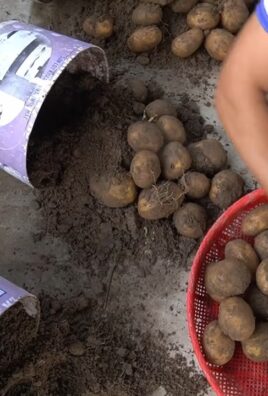Growing White Eggplants at Home might sound like an exotic culinary adventure reserved for seasoned gardeners, but trust me, it’s a surprisingly achievable and rewarding DIY project for anyone! Forget those bland, store-bought vegetables; imagine plucking creamy, ivory-colored eggplants straight from your own backyard.
Eggplants, in general, have a rich history, dating back thousands of years to Asia, where they were initially cultivated for medicinal purposes. Over time, they journeyed westward, becoming a staple in Mediterranean cuisine and eventually finding their way into gardens worldwide. While the familiar purple variety dominates supermarket shelves, the white eggplant offers a unique visual appeal and a subtly sweeter, less bitter flavor profile.
Why should you embark on this DIY journey? Well, for starters, you’ll have access to a unique and delicious ingredient that’s often hard to find commercially. More importantly, growing white eggplants at home allows you to control the entire process, ensuring your produce is free from harmful pesticides and bursting with fresh, homegrown goodness. Plus, let’s be honest, there’s something incredibly satisfying about nurturing a plant from seed to harvest. In this article, I’ll share my tried-and-true tips and tricks to help you successfully cultivate these beautiful and flavorful vegetables, even if you’re a complete beginner. Get ready to impress your friends and family with your gardening prowess and enjoy the delightful taste of homegrown white eggplants!

Weiße Auberginen selbst anbauen: Ein umfassender DIY-Leitfaden
Hallo liebe Gartenfreunde! Habt ihr schon mal weiße Auberginen gesehen? Sie sind nicht nur wunderschön, sondern auch eine tolle Abwechslung zu den klassischen lilafarbenen Sorten. Ich habe mich letztes Jahr entschieden, es selbst zu versuchen, und es war ein voller Erfolg! Deshalb möchte ich euch heute zeigen, wie auch ihr diese ungewöhnlichen Schönheiten in eurem Garten oder sogar auf dem Balkon anbauen könnt. Keine Angst, es ist einfacher als ihr denkt!
Was ihr für den Anbau weißer Auberginen benötigt
Bevor wir loslegen, hier eine Liste der Dinge, die ihr braucht:
* Auberginensamen (weiße Sorte): Achtet darauf, dass ihr hochwertiges Saatgut von einer vertrauenswürdigen Quelle bezieht. Sorten wie ‘Casper’, ‘Bianca’ oder ‘White Egg’ sind gute Optionen.
* Anzuchterde: Diese ist feiner und nährstoffärmer als normale Blumenerde und ideal für die Keimung.
* Anzuchttöpfe oder -schalen: Kleine Töpfe oder Schalen mit Drainagelöchern sind perfekt für die Voranzucht.
* Pflanzerde: Nach der Voranzucht benötigen die Auberginen nährstoffreiche Pflanzerde.
* Töpfe (für den Anbau im Topf) oder ein Beet im Garten: Je nachdem, wo ihr eure Auberginen anbauen möchtet.
* Pflanzstäbe: Auberginenpflanzen können recht hoch werden und benötigen Unterstützung.
* Dünger: Ein organischer Gemüsedünger ist ideal, um die Pflanzen mit ausreichend Nährstoffen zu versorgen.
* Gießkanne oder Gartenschlauch: Zum regelmäßigen Gießen.
* Gartenschere: Zum Ausgeizen und Ernten.
* Ein sonniger Standort: Auberginen lieben die Sonne!
Die Voranzucht: Der Grundstein für eine reiche Ernte
Auberginen haben eine relativ lange Wachstumsperiode, daher ist die Voranzucht im Haus unerlässlich, besonders in kühleren Klimazonen.
1. Aussaat vorbereiten: Füllt eure Anzuchttöpfe oder -schalen mit Anzuchterde. Drückt die Erde leicht an.
2. Samen aussäen: Legt in jeden Topf 2-3 Samen und bedeckt sie mit einer dünnen Schicht Erde (ca. 0,5 cm).
3. Gießen: Befeuchtet die Erde vorsichtig mit einer Sprühflasche oder einer Gießkanne mit feinem Brausekopf. Die Erde sollte feucht, aber nicht nass sein.
4. Warm stellen: Stellt die Töpfe an einen warmen Ort (ca. 22-25°C). Eine Heizmatte kann hier sehr hilfreich sein.
5. Feuchtigkeit halten: Um die Luftfeuchtigkeit zu erhöhen, könnt ihr die Töpfe mit Frischhaltefolie abdecken. Vergesst nicht, regelmäßig zu lüften, um Schimmelbildung zu vermeiden.
6. Keimung abwarten: Die Keimung dauert in der Regel 1-2 Wochen. Sobald die ersten Keimlinge erscheinen, entfernt die Folie.
7. Pikieren: Wenn die Keimlinge 2-3 echte Blätter haben (neben den Keimblättern), ist es Zeit zum Pikieren. Wählt den kräftigsten Keimling pro Topf aus und entfernt die anderen vorsichtig. Setzt den verbleibenden Keimling in einen etwas größeren Topf mit Pflanzerde. Achtet darauf, die Wurzeln nicht zu beschädigen.
Die Auspflanzung: Ab ins Freie!
Sobald die Auberginenpflanzen kräftig genug sind und die Temperaturen es zulassen, können sie ins Freie umziehen.
1. Abhärten: Bevor ihr die Pflanzen ins Freie setzt, solltet ihr sie langsam an die neuen Bedingungen gewöhnen. Stellt sie dazu tagsüber für einige Stunden nach draußen und holt sie abends wieder rein. Steigert die Zeit im Freien jeden Tag, bis die Pflanzen eine ganze Woche draußen verbringen können.
2. Standort vorbereiten: Wählt einen sonnigen Standort mit gut durchlässigem Boden. Wenn ihr die Auberginen in Töpfen anbauen möchtet, wählt große Töpfe (mindestens 10 Liter) mit Drainagelöchern.
3. Pflanzen: Grabt ein Loch, das etwas größer ist als der Wurzelballen der Auberginenpflanze. Setzt die Pflanze vorsichtig hinein und füllt das Loch mit Pflanzerde auf. Drückt die Erde leicht an.
4. Gießen: Gießt die Pflanzen nach dem Einpflanzen gründlich.
5. Pflanzabstand: Achtet auf einen ausreichenden Pflanzabstand (ca. 50-60 cm), damit die Pflanzen genügend Platz zum Wachsen haben.
6. Stützen: Setzt direkt nach dem Pflanzen einen Pflanzstab neben jede Auberginenpflanze, um sie zu stützen.
Die Pflege: Damit eure Auberginen prächtig gedeihen
Die richtige Pflege ist entscheidend für eine reiche Ernte.
1. Gießen: Auberginen benötigen regelmäßige Wassergaben, besonders während der Blütezeit und Fruchtbildung. Gießt am besten morgens, damit die Blätter bis zum Abend abtrocknen können. Vermeidet Staunässe.
2. Düngen: Düngt die Auberginen alle 2-3 Wochen mit einem organischen Gemüsedünger. Achtet auf die Dosierungsanleitung auf der Verpackung.
3. Ausgeizen: Auberginen bilden viele Seitentriebe. Um die Fruchtbildung zu fördern, solltet ihr regelmäßig die Seitentriebe aus den Blattachseln entfernen (ausgeizen). Lasst nur den Haupttrieb und einige wenige Seitentriebe stehen.
4. Mulchen: Eine Mulchschicht aus Stroh oder Rasenschnitt hilft, die Feuchtigkeit im Boden zu halten und Unkraut zu unterdrücken.
5. Schutz vor Schädlingen: Auberginen können von verschiedenen Schädlingen befallen werden, wie z.B. Blattläusen, Kartoffelkäfern oder Spinnmilben. Kontrolliert die Pflanzen regelmäßig und bekämpft Schädlinge bei Bedarf mit biologischen Mitteln.
6. Bestäubung: Auberginen sind Selbstbestäuber, aber eine zusätzliche Bestäubung durch Insekten oder durch leichtes Schütteln der Pflanzen kann die Fruchtbildung verbessern.
Die Ernte: Der Lohn eurer Mühe
Endlich ist es soweit: Die Auberginen sind reif und können geerntet werden!
1. Reife erkennen: Die Auberginen sind reif, wenn sie ihre endgültige Größe erreicht haben und die Schale glänzend und fest ist. Drückt leicht auf die Frucht. Wenn sie leicht nachgibt, ist sie reif.
2. Ernten: Schneidet die Auberginen mit einer Gartenschere ab. Lasst dabei einen kleinen Stiel an der Frucht.
3. Regelmäßig ernten: Erntet die Auberginen regelmäßig, um die Bildung neuer Früchte anzuregen.
4. Lagerung: Auberginen sind nicht lange haltbar. Lagert sie am besten im Kühlschrank und verbraucht sie innerhalb weniger Tage.
Häufige Probleme und Lösungen
Auch beim Anbau von Auberginen können Probleme auftreten. Hier sind einige der häufigsten Probleme und wie ihr sie lösen könnt:
* Blütenfall: Wenn die Blüten abfallen, ohne Früchte zu bilden, kann das verschiedene Ursachen haben, z.B. zu hohe oder zu niedrige Temperaturen, Wassermangel oder Nährstoffmangel. Achtet auf die richtige Pflege und versucht, die Bedingungen zu optimieren.
* Schädlinge: Bekämpft Schädlinge frühzeitig mit biologischen Mitteln.
* Krankheiten: Auberginen können von verschiedenen Pilzkrankheiten befallen werden. Achtet auf eine gute Belüftung und vermeidet Staunässe. Bei Bedarf könnt ihr die Pflanzen mit einem Fungizid behandeln.
Warum weiße Auberginen?
Weiße Auberginen sind nicht nur optisch ein Hingucker, sondern haben auch einen milderen Geschmack als die lilafarbenen Sorten. Sie sind

Conclusion
So, there you have it! Growing white eggplants at home isn’t just a quirky gardening experiment; it’s a gateway to a more flavorful, visually stunning, and ultimately rewarding culinary experience. We’ve walked you through the process, from selecting the right seeds and nurturing seedlings to providing the ideal growing conditions and harvesting your creamy white treasures.
Why is this DIY trick a must-try? Because it empowers you to control the quality and freshness of your produce. Store-bought eggplants, regardless of color, often lack the vibrant flavor and delicate texture of homegrown varieties. White eggplants, in particular, are known for their mildness and creamy consistency, making them incredibly versatile in the kitchen. Imagine the satisfaction of serving a dish featuring eggplants you nurtured from seed to table!
Beyond the superior taste and texture, growing white eggplants offers a unique aesthetic appeal. Their ivory hue adds a touch of elegance to your garden and a sophisticated flair to your dishes. Think of the stunning visual contrast they create when paired with colorful vegetables in a ratatouille or the elegant presentation of grilled white eggplant slices drizzled with balsamic glaze.
But the benefits don’t stop there. Gardening, in general, is a fantastic stress reliever and a great way to connect with nature. Tending to your white eggplant plants provides a sense of accomplishment and a tangible reward for your efforts. Plus, you’ll be reducing your carbon footprint by growing your own food and avoiding the transportation costs associated with store-bought produce.
Ready to take your white eggplant growing to the next level? Consider these variations and suggestions:
* Container Gardening: If you have limited space, white eggplants thrive in large containers. Choose a pot that is at least 18 inches in diameter and filled with well-draining potting mix. This is a great option for balconies, patios, or even indoor growing with sufficient sunlight or grow lights.
* Companion Planting: Enhance your white eggplant’s growth by planting beneficial companions nearby. Basil, thyme, and marigolds are excellent choices, as they deter pests and attract pollinators.
* Grafting: For increased disease resistance and vigor, consider grafting your white eggplant scion onto a more robust rootstock. This technique is particularly useful in areas with challenging growing conditions.
* Different Varieties: Explore different varieties of white eggplants, such as ‘Casper,’ ‘White Beauty,’ or ‘Bianca.’ Each variety offers slightly different characteristics in terms of size, shape, and flavor. Experiment to find your favorite!
* Seed Saving: Once you’ve successfully grown your white eggplants, save the seeds for future planting. This allows you to perpetuate your favorite varieties and become more self-sufficient.
We are confident that with a little patience and care, you can successfully grow beautiful and delicious white eggplants at home. Don’t be afraid to experiment, learn from your mistakes, and most importantly, have fun!
Now, we want to hear from you! Have you tried growing white eggplants before? What challenges did you face, and what tips would you share with other gardeners? Share your experiences, photos, and recipes in the comments below. Let’s create a community of white eggplant enthusiasts and inspire others to embark on this rewarding gardening adventure. Your insights could be invaluable to someone just starting out. So, get your hands dirty, embrace the challenge, and discover the joy of growing your own white eggplants! We can’t wait to see what you create.
Frequently Asked Questions (FAQ)
What are the benefits of growing white eggplants compared to purple eggplants?
White eggplants are generally milder and less bitter than their purple counterparts. They have a creamy texture and a delicate flavor that makes them incredibly versatile in cooking. Some people also find them easier to digest. Additionally, their unique color adds visual appeal to both the garden and the plate. While purple eggplants are delicious in their own right, white eggplants offer a distinct culinary experience that many gardeners and chefs appreciate.
How much sunlight do white eggplants need?
White eggplants, like all eggplants, require at least 6-8 hours of direct sunlight per day to thrive. Insufficient sunlight can lead to leggy growth, reduced fruit production, and smaller, less flavorful eggplants. If you’re growing them indoors, supplement with grow lights to ensure they receive adequate light. When planting outdoors, choose a location that receives full sun throughout the day.
What kind of soil is best for growing white eggplants?
White eggplants prefer well-draining, fertile soil with a pH between 6.0 and 6.8. Amend your soil with compost or other organic matter to improve drainage and nutrient content. Avoid heavy clay soils, as they can become waterlogged and inhibit root growth. A slightly acidic soil is ideal for optimal growth and fruit production.
How often should I water my white eggplant plants?
Water your white eggplant plants deeply and regularly, especially during hot, dry weather. Aim to keep the soil consistently moist but not waterlogged. Water at the base of the plant to avoid wetting the foliage, which can increase the risk of fungal diseases. Mulching around the plants can help retain moisture and suppress weeds. Check the soil moisture regularly and adjust your watering schedule accordingly.
What are some common pests and diseases that affect white eggplants, and how can I prevent them?
Common pests that affect white eggplants include aphids, flea beetles, and spider mites. Diseases include fungal problems like early blight and verticillium wilt. To prevent these problems, practice good garden hygiene, such as removing weeds and debris that can harbor pests and diseases. Use insecticidal soap or neem oil to control pests, and choose disease-resistant varieties whenever possible. Ensure good air circulation around the plants to prevent fungal diseases. Crop rotation can also help reduce the buildup of soilborne pathogens.
When is the best time to harvest white eggplants?
Harvest your white eggplants when they are firm, glossy, and have reached their mature size, typically around 6-8 inches long. The skin should be smooth and unblemished. Gently press the eggplant; it should feel slightly firm but not hard. Overripe eggplants can become bitter and seedy. Use a sharp knife or pruning shears to cut the eggplant from the plant, leaving a short stem attached.
Can I grow white eggplants in containers?
Yes, white eggplants can be successfully grown in containers. Choose a large container that is at least 18 inches in diameter and filled with well-draining potting mix. Ensure the container has drainage holes to prevent waterlogging. Provide adequate sunlight and water regularly. Container-grown eggplants may require more frequent fertilization than those grown in the ground.
How do I fertilize my white eggplant plants?
Fertilize your white eggplant plants regularly with a balanced fertilizer, such as a 10-10-10 or 5-10-5 formula. Apply fertilizer according to the package instructions, typically every 2-3 weeks. You can also use organic fertilizers, such as compost tea or fish emulsion. Avoid over-fertilizing, as this can lead to excessive foliage growth and reduced fruit production.
My white eggplant flowers are falling off without producing fruit. What could be the problem?
Flower drop in eggplants can be caused by several factors, including temperature stress (too hot or too cold), insufficient pollination, or nutrient deficiencies. Ensure your plants are receiving adequate sunlight and water. Hand-pollinate the flowers by gently shaking the plant or using a small brush to transfer pollen from one flower to another. Fertilize with a balanced fertilizer to address any nutrient deficiencies.
How can I save seeds from my white eggplants?
To save seeds from your white eggplants, allow a few fruits to fully mature on the plant. The eggplants will become larger and the skin will become dull and less glossy. Cut the eggplant open and scoop out the seeds. Rinse the seeds thoroughly to remove any pulp. Spread the seeds out on a paper towel to dry completely. Once dry, store the seeds in an airtight container in a cool, dark place. Properly stored seeds can remain viable for several years.




Leave a Comment